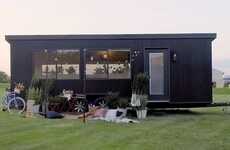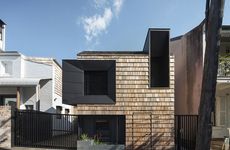
Chris Heininge's Small Living Space is Only 280 Square Feet
Laura McQuarrie — March 11, 2015 — Eco
References: tinyhouse.heininge & treehugger
This small living space may not appeal to those who like to sprawl out at home, but the sustainable space sure is cozy. Measuring under 300 square feet, this dwelling means that homeowners have more money in their pocket and a smaller environmental footprint.
Crafted by builder Chris Heininge in Portland, Oregon, this super small home takes a huge amount of inspiration from the style of Asian homes, which are built to be as practical and space-saving as possible. With smart storage and an ultra efficient layout, the small living space contains a kitchen, bathroom, multi-levels, plus room for guests to sleep. Despite being so small, the house is currently on the market for $70,000, a cost which includes all of the tiny home's appliances.
Crafted by builder Chris Heininge in Portland, Oregon, this super small home takes a huge amount of inspiration from the style of Asian homes, which are built to be as practical and space-saving as possible. With smart storage and an ultra efficient layout, the small living space contains a kitchen, bathroom, multi-levels, plus room for guests to sleep. Despite being so small, the house is currently on the market for $70,000, a cost which includes all of the tiny home's appliances.
Trend Themes
1. Sustainable Micro Dwellings - Disruptive innovation opportunity: Design and build affordable, eco-friendly micro dwellings for individuals seeking minimalist and sustainable living spaces.
2. Space-saving Homes - Disruptive innovation opportunity: Develop innovative space-saving designs and layouts for small living spaces, optimizing functionality without compromising style and comfort.
3. Tiny Home Market - Disruptive innovation opportunity: Create and market affordable, fully-equipped tiny homes to cater to the increasing demand for minimalistic, cost-effective, and environmentally-friendly housing solutions.
Industry Implications
1. Construction - Disruptive innovation opportunity: Integrate sustainable materials and construction techniques to build small, energy-efficient dwellings that reduce environmental impact.
2. Interior Design - Disruptive innovation opportunity: Design and furnish small living spaces with smart storage solutions and multi-purpose furniture, maximizing space and functionality.
3. Real Estate - Disruptive innovation opportunity: Develop and market small, sustainable living spaces as affordable and eco-friendly alternatives for first-time homebuyers and those seeking minimalist lifestyles.
6.9
Score
Popularity
Activity
Freshness























